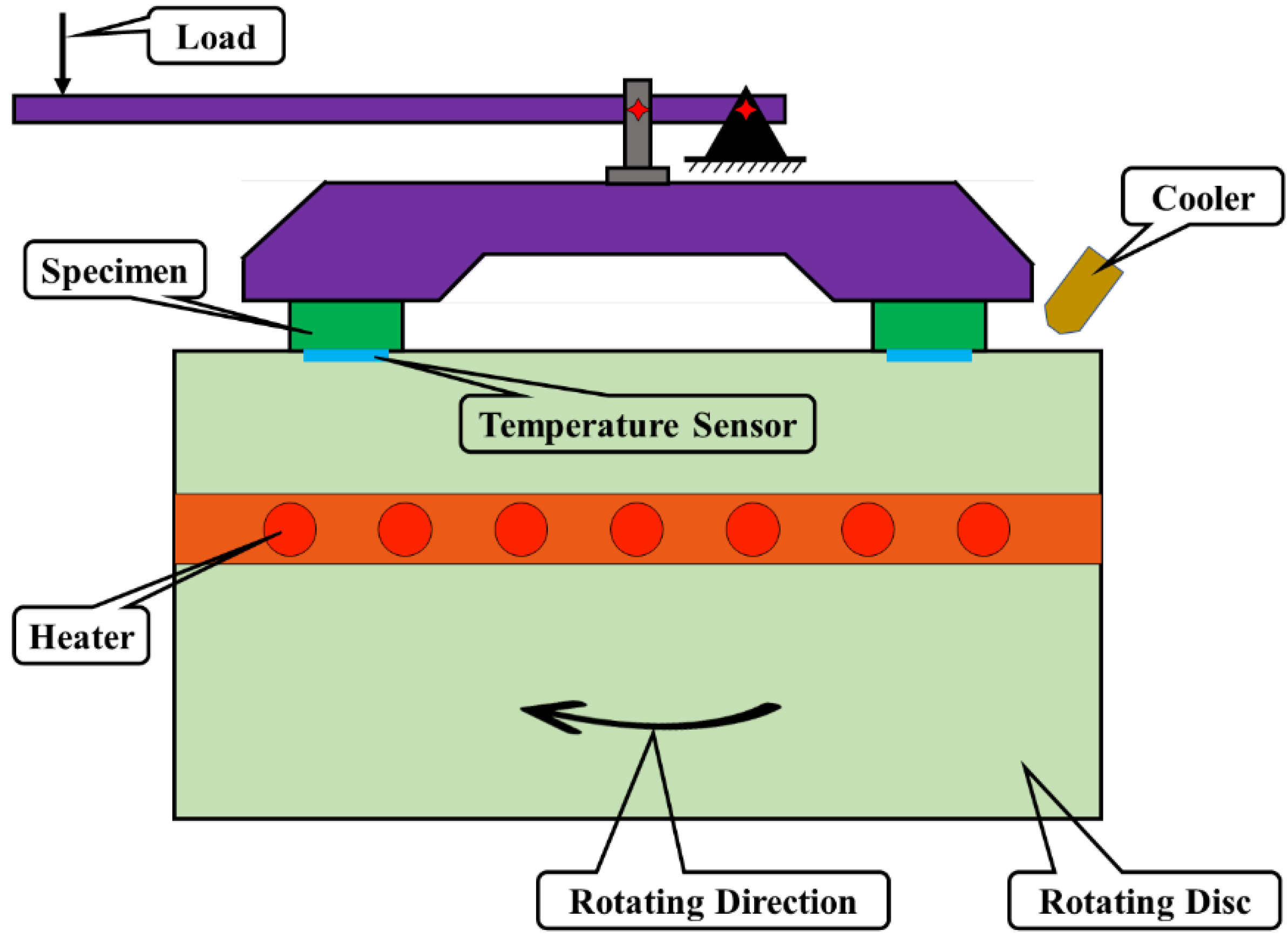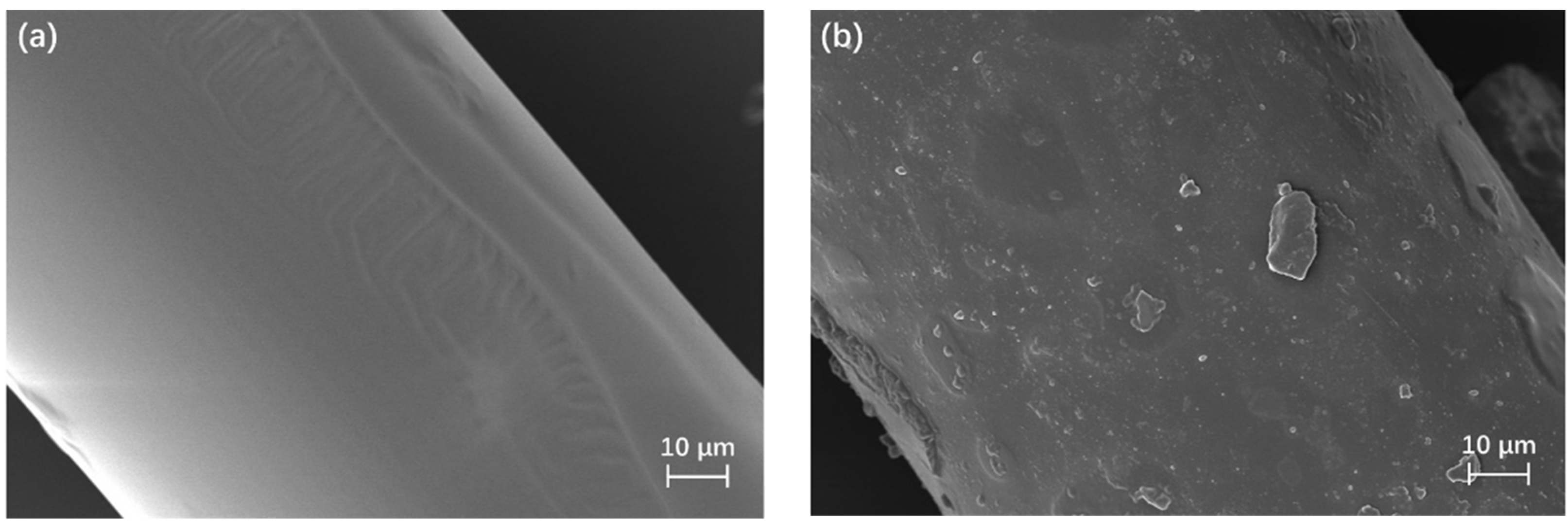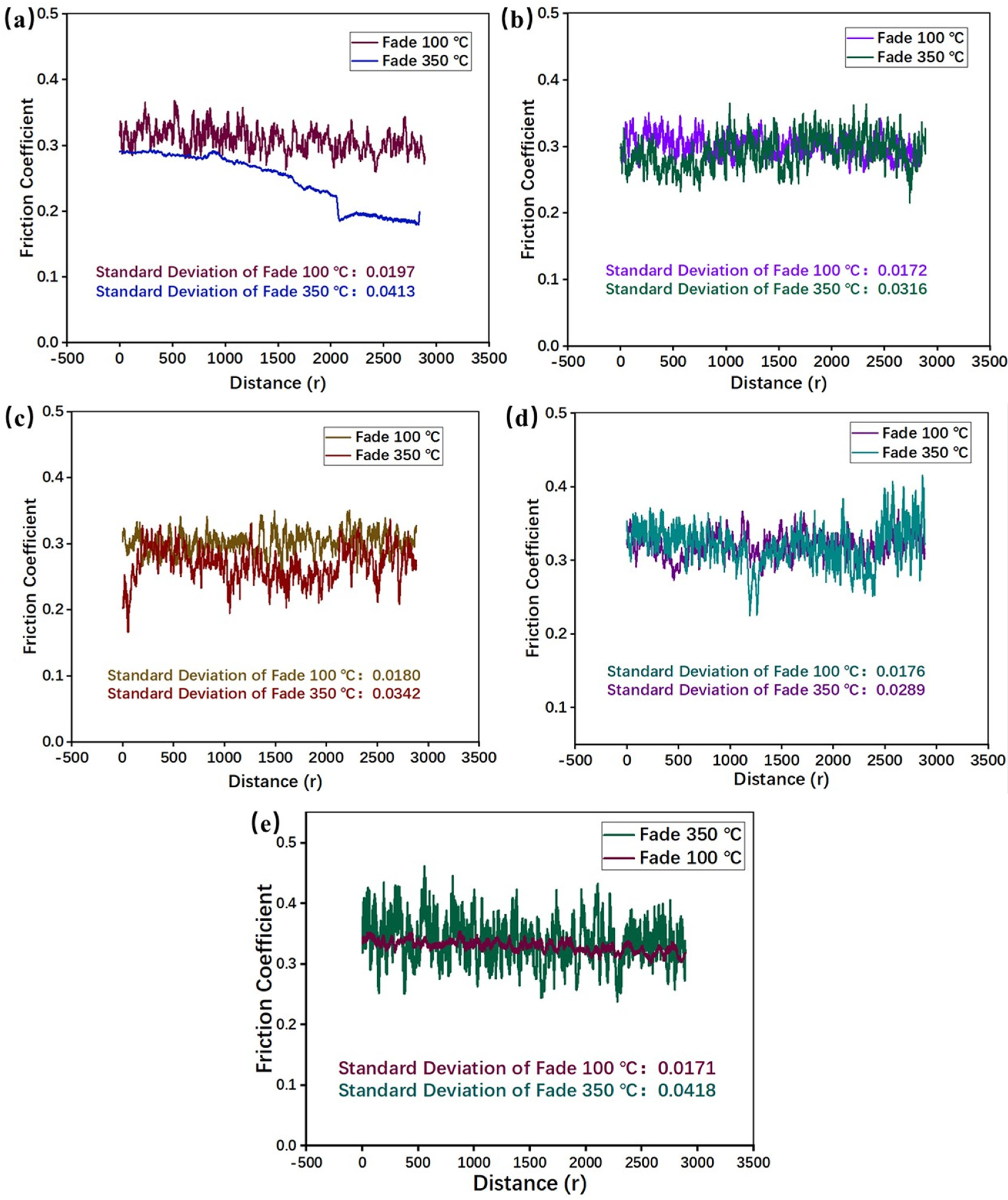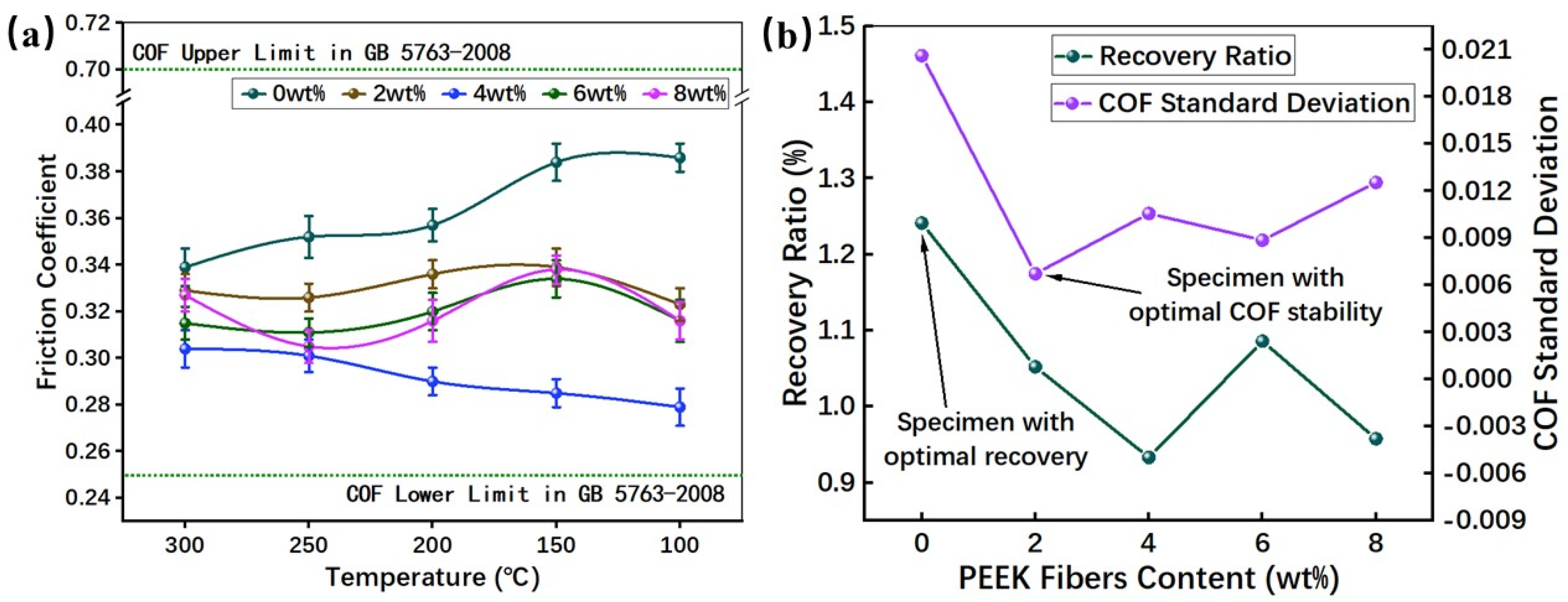Effect of Polymer Ether Ketone Fibers on the Tribological Properties of Resin-Based Friction Materials
Abstract
:1. Introduction
2. Materials and Methods
2.1. Raw Materials
2.2. Fabrication of Specimens
2.3. Testing Methods and Equipment
3. Result and Discussion
3.1. Microstructure of PEEK Fibers
3.2. Fade Resistance
3.3. Recovery Property
3.4. Wear Resistance
3.5. Morphology of the Worn Surface
4. Conclusions
Author Contributions
Funding
Institutional Review Board Statement
Informed Consent Statement
Data Availability Statement
Conflicts of Interest
References
- Zhou, S.; Wang, F.; Chen, J.; Alhashmialameer, D.; Wang, S.; Mahmoud, M.H.H.; Mersal, G.A.M.; Huang, J.; Zhang, Q.; Zhao, G.; et al. Enhanced mechanical, thermal, and tribological performance of 2D-laminated molybdenum disulfide/RGO nanohybrid filling phenolic resin composites. Adv. Compos. Hybrid Mater. 2022, 5, 1206–1220. [Google Scholar] [CrossRef]
- Nogueira, A.P.G.; Leonardi, M.; Straffelini, G.; Gialanella, S. Sliding Behavior and Particle Emissions of Cu-Free Friction Materials with Different Contents of Phenolic Resin. Tribol. Trans. 2020, 63, 770–779. [Google Scholar] [CrossRef]
- Zhao, X.; Ouyang, J.; Tan, Q.; Tan, X.; Yang, H. Interfacial characteristics between mineral fillers and phenolic resin in friction materials. Mater. Express 2020, 10, 70–80. [Google Scholar] [CrossRef]
- Surya Rajan, B.; Sai Balaji, M.A.; Mohamed Aslam Noorani, A.B. Tribological performance of graphene/graphite filled phenolic composites-A comparative study. Compos. Commun. 2019, 15, 34–39. [Google Scholar] [CrossRef]
- Hsissou, R.; Seghiri, R.; Benzekri, Z.; Hilali, M.; Rafik, M.; Elharfi, A. Polymer composite materials: A comprehensive review. Compos. Struct. 2021, 262, 113640. [Google Scholar] [CrossRef]
- Duan, Y.; Shi, Z.; Wang, Y.; Chen, K.; Zhang, Z. Effect of mineral fiber slag removal on friction and wear properties of resin-based friction materials. Mater. Lett. 2021, 293, 129661. [Google Scholar] [CrossRef]
- Alajmi, A.E.; Alotaibi, J.G.; Yousif, B.F.; Nirmal, U. Tribological Studies of Bamboo Fibre Reinforced Epoxy Composites Using a BOD Technique. Polymers 2021, 13, 2444. [Google Scholar] [CrossRef]
- Ismail, A.S.; Jawaid, M.; Naveen, J. Void Content, Tensile, Vibration and Acoustic Properties of Kenaf/Bamboo Fiber Reinforced Epoxy Hybrid Composites. Materials 2019, 12, 2094. [Google Scholar] [CrossRef] [Green Version]
- Mohan, N.; Kumar, R.A.; Rajesh, K.; Prabhu, R.; Preetham, S.; Rakshith, A.N.; Prasad, M.A. Investigation on sliding wear behaviour of UHMWPE filled basalt epoxy composites. AIP Conf. Proc. 2019, 2057, 020048. [Google Scholar] [CrossRef]
- Lu, J.; Li, Y.; Wang, Y.; Fu, Y. Effect of LNBR Content on the Properties of the Carbon Fiber–Reinforced Paper-Based Friction Materials. Tribol. Trans. 2019, 62, 537–547. [Google Scholar] [CrossRef]
- Ahmadijokani, F.; Alaei, Y.; Shojaei, A.; Arjmand, M.; Yan, N. Frictional behavior of resin-based brake composites: Effect of carbon fibre reinforcement. Wear 2019, 420–421, 108–115. [Google Scholar] [CrossRef]
- Ahmadijokani, F.; Shojaei, A.; Arjmand, M.; Alaei, Y.; Yan, N. Effect of short carbon fiber on thermal, mechanical and tribological behavior of phenolic-based brake friction materials. Compos. Part B Eng. 2019, 168, 98–105. [Google Scholar] [CrossRef]
- Liu, Y.; Wang, L.; Liu, D.; Ma, Y.; Tian, Y.; Tong, J.; Senthamaraikannan, P.; Saravanakumar, S. Evaluation of wear resistance of corn stalk fiber reinforced brake friction materials prepared by wet granulation. Wear 2019, 432–433, 102918. [Google Scholar] [CrossRef]
- Ma, Y.; Wu, S.; Zhuang, J.; Tong, J.; Xiao, Y.; Qi, H. The Evaluation of Physio-Mechanical and Tribological Characterization of Friction Composites Reinforced by Waste Corn Stalk. Materials 2018, 11, 901. [Google Scholar] [CrossRef] [PubMed] [Green Version]
- Ning, L.; Deqiang, C.; Xiyan, G.; Lirong, L.; Weizeng, C. Biological tribology properties of the modified polyether ether ketone composite materials. Rev. Adv. Mater. Sci. 2020, 59, 399–405. [Google Scholar] [CrossRef]
- Zheng, B.; Deng, T.; Li, M.; Huang, Z.; Zhou, H.; Li, D. Flexural Behavior and Fracture Mechanisms of Short Carbon Fiber Reinforced Polyether-Ether-Ketone Composites at Various Ambient Temperatures. Polymers 2018, 11, 18. [Google Scholar] [CrossRef] [Green Version]
- Zhang, L.; Ma, S.; Xiu, H.; Lin, Z.; Zhang, Z. Study on the factors affecting the mechanical properties and recovery force of PLA/PEEK blends. Mater. Res. Express 2021, 8, 115701. [Google Scholar] [CrossRef]
- Yu, M.; Zhang, M.; Fang, L.; Ren, M.; Liang, L.; Xie, W.; Ma, P. Wear failure mechanism analysis of self-lubricating fabric composites at high temperature. J. Ind. Text. 2022, 52. [Google Scholar] [CrossRef]
- Pan, Y.; Mao, J.; Ding, J. Fatigue performance of hydroxyapatite filled polyetheretherketone functional gradient biocomposites. Mater. Technol. 2018, 33, 761–768. [Google Scholar] [CrossRef]
- Li, L.; Gao, G.; Tong, J.; Zhuang, J.; Song, W.; Ma, Y.; Liu, G.; Cao, F.; Yuan, S.; Zhang, Q. Tribological and mechanical behaviours of resin-based friction materials based on microcrack filling. Biosurface Biotribology 2022. [Google Scholar] [CrossRef]
- Ma, Y.; Liu, Y.; Menon, C.; Tong, J. Evaluation of Wear Resistance of Friction Materials Prepared by Granulation. ACS Appl. Mater. Interfaces 2015, 7, 22814–22820. [Google Scholar] [CrossRef] [PubMed]
- Yang, Y.; Wang, H.; Ren, J.; Gao, G.; Chen, S.; Wang, N.; Zhao, G.; Wang, J. Core-shell polytetrafluoroethylene @ phenolic resin composites: Structure and tribological behaviors. Tribol. Int. 2020, 144, 106092. [Google Scholar] [CrossRef]
- Li, L.; Zhuang, J.; Tong, T.; Tong, J.; Zhao, X.; Cao, F.; Song, W.; Wang, D.; Tian, Y.; Ma, Y.; et al. Effect of Wet Granulation on Tribological Behaviors of Cu-Based Friction Materials. Materials 2023, 16, 1075. [Google Scholar] [CrossRef]
- Wang, X.; Zhang, C.; Wang, W.; Ru, H. Effect of Granulated Carbon Black Content on Properties of Cu-Fe Friction Material. Rare Met. Mater. Eng. 2018, 47, 302–306. [Google Scholar]
- Lian, W.; Mai, Y.; Wang, J.; Zhang, L.; Liu, C.; Jie, X. Fabrication of graphene oxide-Ti3AlC2 synergistically reinforced copper matrix composites with enhanced tribological performance. Ceram. Int. 2019, 45, 18592–18598. [Google Scholar] [CrossRef]
- Ma, Y.; Wu, S.; Zhuang, J.; Tong, J.; Qi, H. Tribological and physio-mechanical characterization of cow dung fibers reinforced friction composites: An effective utilization of cow dung waste. Tribol. Int. 2018, 131, 200–211. [Google Scholar] [CrossRef]
- Faruk, O.; Bledzki, A.K.; Fink, H.-P.; Sain, M. Biocomposites reinforced with natural fibers: 2000–2010. Prog. Polym. Sci. 2012, 37, 1552–1596. [Google Scholar] [CrossRef]
- Ma, Y.; Liu, Y.; Shang, W.; Gao, Z.; Wang, H.; Guo, L.; Tong, J. Tribological and mechanical properties of pine needle fiber reinforced friction composites under dry sliding conditions. RSC Adv. 2014, 4, 36777–36783. [Google Scholar] [CrossRef]
- Liu, Y.; Ma, Y.; Yu, J.; Zhuang, J.; Wu, S.; Tong, J. Development and characterization of alkali treated abaca fiber reinforced friction composites. Compos. Interfaces 2018, 26, 67–82. [Google Scholar] [CrossRef]
- Liu, Y.; Lv, X.; Bao, J.; Xie, J.; Tang, X.; Che, J.; Ma, Y.; Tong, J. Characterization of silane treated and untreated natural cellulosic fibre from corn stalk waste as potential reinforcement in polymer composites. Carbohydr. Polym. 2019, 218, 179–187. [Google Scholar] [CrossRef]
- Zhang, C.; Wang, X.; Hu, Z.; Wu, Q.; Zhu, H.; Lu, J. Long-term performance of silane coupling agent/metakaolin based geopolymer. J. Build. Eng. 2020, 36, 102091. [Google Scholar] [CrossRef]
- Ahmadijokani, F.; Shojaei, A.; Dordanihaghighi, S.; Jafarpour, E.; Mohammadi, S.; Arjmand, M. Effects of hybrid carbon-aramid fiber on performance of non-asbestos organic brake friction composites. Wear 2020, 452–453, 203280. [Google Scholar] [CrossRef]
- Liu, S.; Dong, C.; Yuan, C.; Bai, X. Study of the synergistic effects of fiber orientation, fiber phase and resin phase in a fiber-reinforced composite material on its tribological properties. Wear 2019, 426–427, 1047–1055. [Google Scholar] [CrossRef]
- Ma, Y.; Liu, Y.; Wang, L.; Tong, J.; Zhuang, J.; Jia, H. Performance assessment of hybrid fibers reinforced friction composites under dry sliding conditions. Tribol. Int. 2018, 119, 262–269. [Google Scholar] [CrossRef]
- Liu, Y.; Ma, Y.; Lv, X.; Yu, J.; Zhuang, J.; Tong, J. Mineral fibre reinforced friction composites: Effect of rockwool fibre on mechanical and tribological behaviour. Mater. Res. Express 2018, 5, 095308. [Google Scholar] [CrossRef]
- Yi, G.; Yan, F. Effect of hexagonal boron nitride and calcined petroleum coke on friction and wear behavior of phenolic resin-based friction composites. Mater. Sci. Eng. A 2006, 425, 330–338. [Google Scholar] [CrossRef]
- Dadkar, N.; Tomar, B.S.; Satapathy, B.K. Evaluation of flyash-filled and aramid fibre reinforced hybrid polymer matrix composites (PMC) for friction braking applications. Mater. Des. 2009, 30, 4369–4376. [Google Scholar] [CrossRef]
- Jara, D.C.; Jang, H. Synergistic effects of the ingredients of brake friction materials on friction and wear: A case study on phenolic resin and potassium titanate. Wear 2019, 430–431, 222–232. [Google Scholar] [CrossRef]
- Lee, J.-J.; Kwon, S.; Kim, J.-J. Effect of different reinforcement materials on the formation of secondary plateaus and friction properties in friction materials for automobiles. Tribol. Int. 2018, 120, 70–79. [Google Scholar] [CrossRef]
- Greco, A.C.; Erck, R.; Ajayi, O.; Fenske, G. Effect of reinforcement morphology on high-speed sliding friction and wear of PEEK polymers. Wear 2011, 271, 2222–2229. [Google Scholar] [CrossRef]
- Zhang, G.; Yu, H.; Zhang, C.; Liao, H.; Coddet, C. Temperature dependence of the tribological mechanisms of amorphous PEEK (polyetheretherketone) under dry sliding conditions. Acta Mater. 2008, 56, 2182–2190. [Google Scholar] [CrossRef]
- Eriksson, M.; Jacobson, S. Tribological surfaces of organic brake pads. Tribol. Int. 2000, 33, 817–827. [Google Scholar] [CrossRef]
- Bijwe, J.; Nidhi; Majumdar, N.; Satapathy, B.K. Influence of modified phenolic resins on the fade and recovery behavior of friction materials. Wear 2005, 259, 1068–1078. [Google Scholar] [CrossRef]
- Vijay, R.; Singaravelu, D.L.; Jayaganthan, R. Development and characterization of stainless steel fiber-based copper-free brake liner formulation—A positive solution for steel fiber replacement. Friction 2019, 1–26. [Google Scholar] [CrossRef]
- Bijwe, J.; Kumar, M. Optimization of steel wool contents in non-asbestos organic (NAO) friction composites for best combination of thermal conductivity and tribo-performance. Wear 2007, 263, 1243–1248. [Google Scholar] [CrossRef]
- Kumar, M.; Bijwe, J. Role of different metallic fillers in non-asbestos organic (NAO) friction composites for controlling sensitivity of coefficient of friction to load and speed. Tribol. Int. 2010, 43, 965–974. [Google Scholar] [CrossRef]
- Eriksson, M.; Bergman, F.; Jacobson, S. On the nature of tribological contact in automotive brakes. Wear 2002, 252, 26–36. [Google Scholar] [CrossRef]
- Zhang, D.; Li, Z.; Klausen, L.H.; Li, Q.; Dong, M. Friction behaviors of two-dimensional materials at the nanoscale. Mater. Today Phys. 2022, 27. [Google Scholar] [CrossRef]
- Sun, W.; Zhou, W. Effects of friction film mechanical properties on the tribological performance of ceramic enhanced resin matrix friction materials. J. Mater. Res. Technol. 2019, 8, 4705–4712. [Google Scholar] [CrossRef]
- Ma, J.; Li, Z.; Xue, Y.; Liang, X.; Tan, Z.; Tang, B. Novel PEEK/nHA composites fabricated by hot-pressing of 3D braided PEEK matrix. Adv. Compos. Hybrid Mater. 2020, 3, 156–166. [Google Scholar] [CrossRef]
- Fu, Y.; Zhou, L.; Yin, T.; Luo, Z.; Li, H.; Qi, L. A new kind of resin-based wet friction material: Non-woven fabrics with isotropic fiber networks as preforms. Friction 2020, 9, 92–103. [Google Scholar] [CrossRef] [Green Version]
- Fei, J.; Wang, H.-K.; Huang, J.-F.; Zeng, X.-R.; Luo, W. Effects of carbon fiber length on the tribological properties of paper-based friction materials. Tribol. Int. 2014, 72, 179–186. [Google Scholar] [CrossRef]
- Su, L.; Gao, F.; Han, X.; Chen, J. Effect of copper powder third body on tribological property of copper-based friction materials. Tribol. Int. 2015, 90, 420–425. [Google Scholar] [CrossRef]
- Lee, H.G.; Kim, S.S.; Gil Lee, D. Effect of compacted wear debris on the tribological behavior of carbon/epoxy composites. Compos. Struct. 2006, 74, 136–144. [Google Scholar] [CrossRef]
- Kim, H.J.; Windl, W.; Rigney, D. Structure and chemical analysis of aluminum wear debris: Experiments and ab initio simulations. Acta Mater. 2007, 55, 6489–6498. [Google Scholar] [CrossRef]
- El-Tayeb, N.; Liew, K. Effect of water spray on friction and wear behaviour of noncommercial and commercial brake pad materials. J. Mater. Process. Technol. 2008, 208, 135–144. [Google Scholar] [CrossRef]
- Jin, H.; Zhou, K.; Ji, Z.; Tian, X.; Chen, Y.; Lu, L.; Ren, Y.; Xu, C.; Duan, S.; Li, J.; et al. Comparative tribological behavior of friction composites containing natural graphite and expanded graphite. Friction 2019, 8, 684–694. [Google Scholar] [CrossRef] [Green Version]
- Zhuang, J.; Liu, Y.; Cao, Z.; Li, Y. Microstructure and Wear Resistance of Cu-TiC Composites Fabricated by Mechanical Alloying and Spark Plasma Sintering. Adv. Mater. Res. 2011, 213, 524–528. [Google Scholar] [CrossRef]











| Raw Materials (by ωt%) | Specimens | ||||
|---|---|---|---|---|---|
| RBFM-1 | RBFM-2 | RBFM-3 | RBFM-4 | RBFM-5 | |
| PEEK Fibers | 0 | 2.00 | 4.00 | 6.00 | 8.00 |
| Sepiolite Fibers | 5.00 | 5.00 | 5.00 | 5.00 | 5.00 |
| Compound Mineral Fibers | 20.00 | 20.00 | 20.00 | 20.00 | 20.00 |
| Phenolic Powders | 9.00 | 9.00 | 9.00 | 9.00 | 9.00 |
| Graphite | 8.00 | 8.00 | 8.00 | 8.00 | 8.00 |
| Petroleum Coke | 7.00 | 7.00 | 7.00 | 7.00 | 7.00 |
| Aluminum Oxide | 6.00 | 6.00 | 6.00 | 6.00 | 6.00 |
| Friction Dust | 2.00 | 2.00 | 2.00 | 2.00 | 2.00 |
| Calcium Carbonate | 13.00 | 13.00 | 13.00 | 13.00 | 13.00 |
| Vermiculite Powder | 5.00 | 5.00 | 5.00 | 5.00 | 5.00 |
| Barium Sulfate | 24.00 | 22.00 | 20.00 | 18.00 | 16.00 |
| Zinc Stearate | 1.00 | 1.00 | 1.00 | 1.00 | 1.00 |
| Raw Materials | Size (mesh) | Shape | Supply | Properties |
|---|---|---|---|---|
| PEEK Fibers | Diameter: 0.1 mm; Length: 3 mm | Fiber | Changzhou Chuangying New Material Technology Co., LTD. Changzhou, China | Glass transition temperature: 143 °C; Melting point: 343 °C |
| Sepiolite Fibers | Diameter: 0.15 mm; Length: 2.5 mm | Fiber | Lingshou Jiasuo Building Materials Processing Co. LTD. Shijiazhuang, China | High temperature resistance |
| Compound Mineral Fibers | Diameter: 0.2 mm; Length: 3 mm | Fiber | Shijiazhuang Mayue Building Materials Co. LTD. Shijiazhuang, China | Apparent density: 0.13–0.20 g/cm3 |
| Phenolic Powders | 200 mesh | Irregularity | Henan Borun Casting Material Co. LTD. Zhengzhou, China | Soften temperature: 95–110 °C |
| Graphite | 100 mesh | Flake | Henan Borun Casting Material Co. LTD | Density: 2.1–2.3 g/cm3 |
| Petroleum Coke | 400 mesh | Irregularity | Shijiazhuang Yuxin Building Materials Co. LTD, Shijiazhuang, China | Density: 1.97–2.15 g/cm3 |
| Aluminum Oxide | 325 mesh | Globular | Henan Borun Casting Material Co. LTD | Density: 3.9–4.0 g/cm3 |
| Friction Dust | 100 mesh | Irregularity | Henan Borun Casting Material Co. LTD | Aiming to reduce braking noise |
| Calcium Carbonate | 1250 mesh | Irregularity | Shandong Yusuo Chemical Technology Co. LTD. Linyi, China | Density: 2.8 g/cm3 |
| Vermiculite Powder | 30 mesh | Irregularity | Lingshou Xuyang Mining Co. LTD. Shijiazhuang, China | Density: 2.5 g/cm3 |
| Barium Sulfate | 325 mesh | Irregularity | Shandong Yusuo Chemical Technology Co. LTD | Density: 4.3 g/cm3 |
| Zinc Stearate | 200 mesh | Irregularity | Wuxi Yatai Joint Chemical Co. LTD. Wuxi, China | Density: 1.1 g/cm3 |
| Composition | Distilled Water | Absolute Ethyl Alcohol | SCA |
|---|---|---|---|
| Content (by ωt%) | 8 | 72 | 20 |
Disclaimer/Publisher’s Note: The statements, opinions and data contained in all publications are solely those of the individual author(s) and contributor(s) and not of MDPI and/or the editor(s). MDPI and/or the editor(s) disclaim responsibility for any injury to people or property resulting from any ideas, methods, instructions or products referred to in the content. |
© 2023 by the authors. Licensee MDPI, Basel, Switzerland. This article is an open access article distributed under the terms and conditions of the Creative Commons Attribution (CC BY) license (https://creativecommons.org/licenses/by/4.0/).
Share and Cite
Li, L.; Ma, Z.; Liu, G.; Tong, J.; Song, W.; Ren, L.; Tong, T.; Ma, Y. Effect of Polymer Ether Ketone Fibers on the Tribological Properties of Resin-Based Friction Materials. Materials 2023, 16, 2094. https://doi.org/10.3390/ma16052094
Li L, Ma Z, Liu G, Tong J, Song W, Ren L, Tong T, Ma Y. Effect of Polymer Ether Ketone Fibers on the Tribological Properties of Resin-Based Friction Materials. Materials. 2023; 16(5):2094. https://doi.org/10.3390/ma16052094
Chicago/Turabian StyleLi, Lekai, Zichao Ma, Guoqin Liu, Jin Tong, Wei Song, Lili Ren, Tianjian Tong, and Yunhai Ma. 2023. "Effect of Polymer Ether Ketone Fibers on the Tribological Properties of Resin-Based Friction Materials" Materials 16, no. 5: 2094. https://doi.org/10.3390/ma16052094






